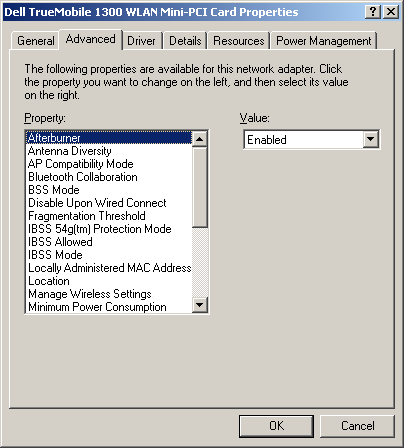Afterburner
From DD-WRT Wiki
(Difference between revisions)
| Revision as of 05:41, 25 October 2006 (edit) Whiteboy (Talk | contribs) ← Previous diff |
Revision as of 05:43, 25 October 2006 (edit) (undo) Whiteboy (Talk | contribs) Next diff → |
||
| Line 1: | Line 1: | ||
| + | [[Image:Afterburner_Client_MiniPCI_Windows_XP.png|frame|300px|right|Afterburner in Windows XP]] | ||
| Despite previous postings and the help info in DD-WRT Web GUI that Afterburner only works on the GS models, this speed-enhancing feature ''is'' available on all DD-WRT-capable G routers. It is hardware independent. Speedbooster will only improve speeds when used with clients that also have the Speedbooster/Afterburner feature; use with "normal" 802.11g clients will actually lower performance. | Despite previous postings and the help info in DD-WRT Web GUI that Afterburner only works on the GS models, this speed-enhancing feature ''is'' available on all DD-WRT-capable G routers. It is hardware independent. Speedbooster will only improve speeds when used with clients that also have the Speedbooster/Afterburner feature; use with "normal" 802.11g clients will actually lower performance. | ||
| Line 4: | Line 5: | ||
| * Afterburner can help in environments dense with wireless signals. | * Afterburner can help in environments dense with wireless signals. | ||
| * Many MiniPCI cards built into notebooks and many PC Cards are based on Broadcom chips whose configurations support Afterburner <br> | * Many MiniPCI cards built into notebooks and many PC Cards are based on Broadcom chips whose configurations support Afterburner <br> | ||
| - | [[Image:Afterburner_Client_MiniPCI_Windows_XP.png|thumb|300px|right|Afterburner in Windows XP]] | ||
| Afterburner is also known as: | Afterburner is also known as: | ||
Revision as of 05:43, 25 October 2006
Despite previous postings and the help info in DD-WRT Web GUI that Afterburner only works on the GS models, this speed-enhancing feature is available on all DD-WRT-capable G routers. It is hardware independent. Speedbooster will only improve speeds when used with clients that also have the Speedbooster/Afterburner feature; use with "normal" 802.11g clients will actually lower performance.
- Afterburner can be used in networks that also have 802.11b devices, and will not disable the use of them.
- Afterburner can help in environments dense with wireless signals.
- Many MiniPCI cards built into notebooks and many PC Cards are based on Broadcom chips whose configurations support Afterburner
Afterburner is also known as:
- SpeedBooster
- SuperSpeed
- TurboG 125mbps
- HSP125
- G+
Afterburner is not:
- Super-G / 108 mbps (they are not based on the same technology)
Links
Brainslayer's Clarification of SpeedBooster
Hyperwrt
Tomsnetworking
wi-fiplanet.com
